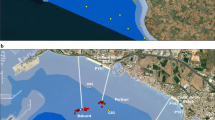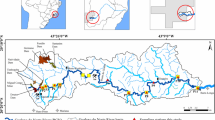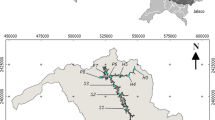Abstract
Ninety-two surface sediment samples were collected in Guanabara Bay, one of the most prominent urban bays in SE Brazil, to investigate the spatial distribution of anthropogenic pollutants. The concentrations of heavy metals, organic carbon and particle size were examined in all samples. Large spatial variations of heavy metals and particle size were observed. The highest concentrations of heavy metals were found in the muddy sediments from the north western region of the bay near the main outlets of the most polluted rivers, municipal waste drainage systems and one of the major oil refineries. Another anomalous concentration of metals was found adjacent to Rio de Janeiro Harbour. The heavy metal concentrations decrease to the northeast, due to intact rivers and the mangrove systems in this area, and to the south where the sand fraction and open-marine processes dominate. The geochemical normalization of metal data to Li or Al has also demonstrated that the anthropogenic input of heavy metals have altered the natural sediment heavy metal distribution.






Similar content being viewed by others
References
Abrahim G, Parker R (2002) Heavy-metal contaminants in Tamaki Estuary: impact of city development and growth, Auckland, New Zealand. Environ Geol 42:883–890
Ackeman F (1980) A procedure for correcting grain size effect in heavy metal analysis of estuarine and coastal sediments. Environ Technol Lett 1:518–527
Aloupi M, Angelidis MO (2001) Geochemistry of natural and anthropogenic metals in the coastal sediments of the island of Lesvos, Aegean Sea. Environ Pollut 113:211–219
Amador ES (1980) Assoreamento da Baía de Guanabara—taxas de sedimentação. An Acad Bras Ciênc 52(4):723–742
Balls PW, Hull S, Miller BS, Pirie JM, Proctor W (1997) Trace metal in Scottish estuarine and coastal sediments. Mar Pollut Bull 34(1):42–50
Baptista Neto JA, Smith BJ, Mcalliste JJ (1999) Concentrações de metais pesados em sedimentos de escoamento superficial urbano: implicações quanto à qualidade ambiental de Niterói, RJ, Brasil. An Acad Bras Ciênc 4:981–995
Baptista Neto JA, Smith BJ, Mcalliste JJ (2000) Heavy metal concentrations in surface sediments in a nearshore environment, Jurujuba Sound, SE Brazil. Environ Pollut 109(1):1–9
Baptista Neto JA, Crapez M, Vilela CG, McAllister JJ (2005) Concentration and bioavailability of heavy metals in sediments from Niterói harbour/S.E. Brazil. J Coast Res 21(4):811–817
Barrocas PR, Wasserman JC (1993) O mercúrio na Baía de Guanabara: uma revisão histórica. Programa de Pós-graduação em Geoquímica, UFF, Niterói, RJ, 115–127
Calvert SE, Mukherjee S, Morris RJ (1985) Trace metals in fulvic and humic acids from modern organic-rich sediments. Oceanol Acta 8:167–173
Carreira RS, Wagener ALR, Readman JW, Fileman TW, Macko SA, Veiga A (2002) Change in the sedimentary organic carbon pool of a fertilized tropical estuary, Guanabara Bay, Brazil: an elemental, isotopic and molecular marker approach. Mar Chem 79:207–227
Cox ME, Preda M (2003) Trace metal distribution and relation to marine sediment mineralogy, Gulf of Carpentaria, Northern Australia. Mar Pollut Bull 46:1622–1629
Faria MM, Sanchez BA (2001) Geochemistry and mineralogy of recent sediments of Guanabara Bay (NE sector) and its major rivers—Rio de Janeiro State—Brazil. An Acad Bras Ciênc 73(1):121–133
FEEMA (1990) Projeto de recuperação gradual da Baía de Guanabara, vol 1. Fundação Estadual de Engenharia do Meio Ambiente, Rio de Janeiro, RJ, Brazil, 203pp
Folk RL (1974) Petrology of sedimentary rocks. Hemphill, Austin, Texas, 182pp
Godoy JM, Moreira I, Bragança MJ, Wanderley C, Mendes LB (1998) A study of Guanabara Bay sedimentation rates. J Radioanal Nucl Chem 227(1–2):157–160
Gonzáles-Caccia V (2002) Distribuición de Metales Traza en el agua de mar y sedimentos de la Bahía de Florida. Doctoral dissertation, Universidad Politécnica de Catalunya, Barcelona, Spain 174p
Gough LP, Kotra RK, Colmes CW, Orem WH, Hageman PL, Briggs PH, Meier AL, Brown ZA (1996) Regional geochemistry of metals in organic rich sediments, sawgrass and surface water, from Taylos Slough, Florida. USGS Open File Report (OFR-00-327)
Grousset FE, Quetel CR, Thomas B, Donard OFX, Lambert CE, Quillard F, Monaco A (1995) Anthropogenic vs. lithogenic origins of trace elements (As, Cd, Pb, Rb, Sb, Sc, Sn, Zn) in water column particles northwestern: Mediterranean sea. Mar Chem 48:291–310
Huang K, Lin S (2003) Consequences and implication of heavy metal spatial variations in sediments of Keelung River drainage basin, Taiwan. Chemosphere 53:1113–1121
JICA (1994) The study on recuperation of the Guanabara Bay ecosystem, vol 8. Japan International Cooperation Agency, Kokusai Kogyo Co., Ltd., Tokyo
Kennish MJ (1992) Ecology of estuaries: anthropogenic effects. Marine science series. CRC Press, USA
Kjerfve B, Ribeiro CA, Dias GTM, Filippo A, Quaresma VS (1997) Oceanographic characteristics of an impacted coastal bay: Baía de Guanabara, Rio de Janeiro, Brazil. Cont Shelf Res 17(13):1609–1643
Lacerda LD, Pfeiffer WC, Fiszman M (1987) Heavy metal distribution, availability and fate in Sepetiba Bay, S.E. Brazil. Sci Total Environ 65:163–173
Leal M, Wagener A (1993) Remobilization of anthropogenic copper deposited in sediments of a tropical estuary. Chem Speciation Bioavailability 24(1):31–39
Legorburu I, Coanton L (1991) Heavy metal concentration in sediments from Pasajes harbour, Spain. Mar Pollut Bull 22:207–209
Lin S, Hsieh IJ, Huang KM, Wamg CH (2002) Influence of the Yangtze River and grain size on the spatial variations of heavy metals and organic carbon in the East China Sea continental shelf sediments. Chem Geol 182:377–394
Martin JM, Meybeck M (1979) Elemental mass-balance of material carried by major world rivers. Mar Chem 7:173–206
Mecray EL, Brink MRBT (2000) Contaminant distribution and accumulation in the surface sediments of long island sound. J Coast Res 16(3):575–590
Muniz P, Danulat E, Yannicelli B, García-Alonso J, Medina G, Bícego MC (2003) Assessment of contamination by heavy metals and petroleum hydrocarbons in sediments of Montevideo harbour (Uruguay). Environ Int 1096:1–10
Nimer E (1989) Climatologia do Brasil. Rio de Janeiro: Instituto Brasileiro de Geografia e Estatística—IBGE, pp 422
Nriagu JO (1989) A global assessment of natural sources of atmospheric trace metals. Nature 338:47–49
Quaresma VS, Dias GTM, Baptista Neto JA (2000) Caracterização da ocorrência de padrões de sonar de varredura lateral e sísmica de alta frequência (3,5 e 7,0 kHz) na porção sul da Baía de Guanabara—RJ. Braz J Geophys 18(2):201–214
Rebello A, Haekel W, Moreira I, Santelli R, Schroeder F (1986) The fate of heavy metals in an estuarine tropical system. Mar Chem 18:215–225
Ruiz F (2001) Trace metals in estuarine sediments from the southwestern Spanish coast. Mar Pollut Bull 42:482–490
Rule JH (1986) Assessment of trace element geochemistry of Hampton roads harbour and lower Chesapeake Bay area sediments. Environ Geol Water Sci 8:209–219
Salomons W, Förstner U (1984) Metals in the hydrocycle. Springer, Berlin Heidelberg New York, p 349
Soto-Jiménez MF, Páez-Osuna E (2001) Distribution and normalization of heavy metal concentrations in Mangrove and Lagoonal sediments from Mazatlán Harbor (SE Gulf of California). Estuarine Coast Shelf Sci 53:259–274
Spencer KL (2002) Spatial variability of metals in the inter-tidal sediments of the meadway estuary, Kent, UK. Mar Pollut Bull 44:933–944
Subramanian V, Itta PK, Griekan RV (1988) Heavy metals in the Ganges Estuary. Mar Pollut Bull 19(6):290–293
Szefer P, Glasby GP, Szefer K, Pempkowiak J, Kaliszan R (1996) Heavy metal pollution in surficial sediments from the southern Baltic Sea off Poland. J Environ Sci Health 31A:2723–2754
Turekian KK, Wedepohl KH (1961) Distribution of elements in some major units of the earth’s crust. Geol Soc Am Bull 72:175–192
Vandenberg C, Rebello AL (1986) Organic-copper interactions in Guanabara Bay, Brazil—an electrochemical study of copper complexation by dissolved organic material in a tropical bay. Sci Total Environ 58(1–2):37–45
Vilela CG, Batista DS, Baptista Neto JA, Crapez M, McAllister JJ (2004) Benthonic Foraminifera distribution in a high polluted sediment from Niterói Harbour (Guanabara Bay), Rio de Janeiro, Brazil. An Acad Bras Ciênc 76(1):1–11
Wagener ALR (1995) Burial of organic carbon in estuarine zones—estimates for Guanaraba Bay, Rio de Janeiro. Quím Nova 18(6):534–535
Windom HL, Schropp SJ, Calder FD, Ryan JD, Smith RG, Burney LC, Lewis FG, Rawlinson CH (1989) Natural trace metal concentrations in estuarine and coastal marine sediments of the southeastern United States. Environ Sci Technol 23:314–320
Wong PTS, Silverberg BA, Chau YK, Hudson PV (1978) Lead and aquatic biota. In: Nriagu JO (eds) Biogeochemistry and lead in the environment. Elsevier, Amsterdam
Acknowledgements
Funding for this project was provided through a cooperation programme funded by the “Internationales Büro Nord-und Südamerika des BMBF (Germany; BRA99/036MAR)” and a research grant from FAPERJ (Rio de Janeiro State Science Foundation) and CNPq (Brazilian Science Foundation). The writers are also indebted to Dr. Cleverson G. Silva for fieldwork assistance and the MSc students from Departamento de Geologia UFF for their help during the fieldwork.
Author information
Authors and Affiliations
Corresponding author
Rights and permissions
About this article
Cite this article
Neto, J.A.B., Gingele, F.X., Leipe, T. et al. Spatial distribution of heavy metals in surficial sediments from Guanabara Bay: Rio de Janeiro, Brazil. Environ Geol 49, 1051–1063 (2006). https://doi.org/10.1007/s00254-005-0149-1
Received:
Accepted:
Published:
Issue Date:
DOI: https://doi.org/10.1007/s00254-005-0149-1




